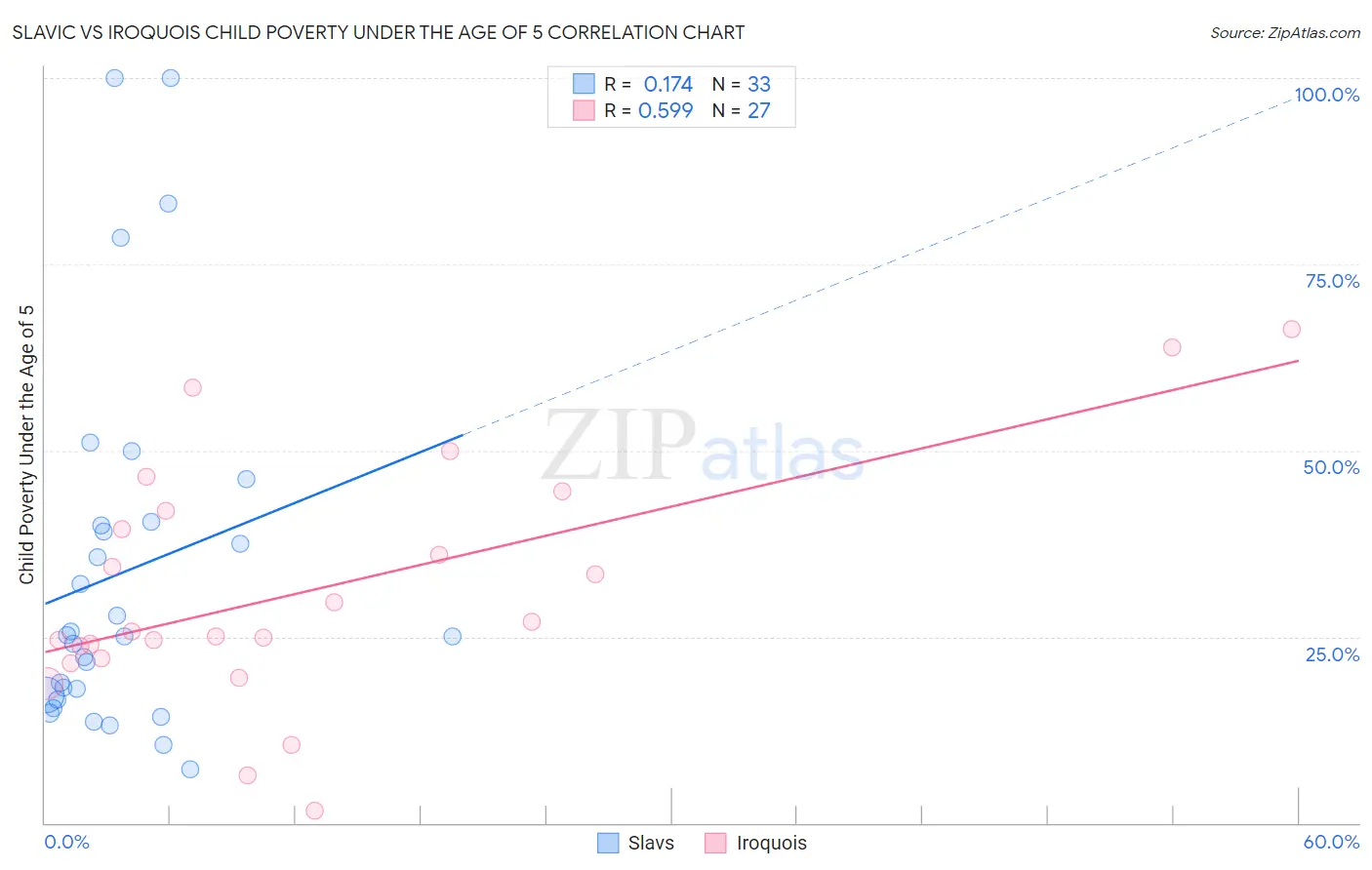Slavic vs Iroquois Child Poverty Under the Age of 5
COMPARE
Slavic
Iroquois
Child Poverty Under the Age of 5
Child Poverty Under the Age of 5 Comparison
Slavs
Iroquois
17.0%
CHILD POVERTY UNDER THE AGE OF 5
64.0/ 100
METRIC RATING
166th/ 347
METRIC RANK
22.0%
CHILD POVERTY UNDER THE AGE OF 5
0.0/ 100
METRIC RATING
302nd/ 347
METRIC RANK
Slavic vs Iroquois Child Poverty Under the Age of 5 Correlation Chart
The statistical analysis conducted on geographies consisting of 261,045,487 people shows a poor positive correlation between the proportion of Slavs and poverty level among children under the age of 5 in the United States with a correlation coefficient (R) of 0.174 and weighted average of 17.0%. Similarly, the statistical analysis conducted on geographies consisting of 202,992,045 people shows a substantial positive correlation between the proportion of Iroquois and poverty level among children under the age of 5 in the United States with a correlation coefficient (R) of 0.599 and weighted average of 22.0%, a difference of 29.6%.

Child Poverty Under the Age of 5 Correlation Summary
| Measurement | Slavic | Iroquois |
| Minimum | 7.2% | 1.6% |
| Maximum | 100.0% | 66.3% |
| Range | 92.8% | 64.7% |
| Mean | 33.6% | 31.3% |
| Median | 25.0% | 25.7% |
| Interquartile 25% (IQ1) | 16.9% | 22.1% |
| Interquartile 75% (IQ3) | 40.2% | 41.9% |
| Interquartile Range (IQR) | 23.3% | 19.8% |
| Standard Deviation (Sample) | 24.5% | 16.1% |
| Standard Deviation (Population) | 24.1% | 15.8% |
Similar Demographics by Child Poverty Under the Age of 5
Demographics Similar to Slavs by Child Poverty Under the Age of 5
In terms of child poverty under the age of 5, the demographic groups most similar to Slavs are Immigrants from Uzbekistan (17.0%, a difference of 0.22%), Immigrants from Colombia (16.9%, a difference of 0.34%), Uruguayan (17.0%, a difference of 0.39%), Immigrants from Oceania (16.9%, a difference of 0.43%), and Immigrants from South America (17.1%, a difference of 0.44%).
| Demographics | Rating | Rank | Child Poverty Under the Age of 5 |
| Immigrants | Syria | 72.3 /100 | #159 | Good 16.8% |
| Irish | 72.0 /100 | #160 | Good 16.8% |
| English | 70.4 /100 | #161 | Good 16.8% |
| Costa Ricans | 69.8 /100 | #162 | Good 16.9% |
| Scottish | 68.6 /100 | #163 | Good 16.9% |
| Immigrants | Oceania | 67.6 /100 | #164 | Good 16.9% |
| Immigrants | Colombia | 66.9 /100 | #165 | Good 16.9% |
| Slavs | 64.0 /100 | #166 | Good 17.0% |
| Immigrants | Uzbekistan | 62.0 /100 | #167 | Good 17.0% |
| Uruguayans | 60.5 /100 | #168 | Good 17.0% |
| Immigrants | South America | 60.0 /100 | #169 | Good 17.1% |
| Immigrants | Western Asia | 59.2 /100 | #170 | Average 17.1% |
| Immigrants | Morocco | 58.9 /100 | #171 | Average 17.1% |
| Yugoslavians | 54.1 /100 | #172 | Average 17.2% |
| Welsh | 54.0 /100 | #173 | Average 17.2% |
Demographics Similar to Iroquois by Child Poverty Under the Age of 5
In terms of child poverty under the age of 5, the demographic groups most similar to Iroquois are Inupiat (22.0%, a difference of 0.090%), Immigrants from Central America (22.0%, a difference of 0.17%), Immigrants from Guatemala (22.0%, a difference of 0.20%), Chickasaw (21.8%, a difference of 0.83%), and Alaskan Athabascan (21.8%, a difference of 0.83%).
| Demographics | Rating | Rank | Child Poverty Under the Age of 5 |
| Cherokee | 0.0 /100 | #295 | Tragic 21.7% |
| Yaqui | 0.0 /100 | #296 | Tragic 21.7% |
| Hispanics or Latinos | 0.0 /100 | #297 | Tragic 21.7% |
| Blackfeet | 0.0 /100 | #298 | Tragic 21.8% |
| Chickasaw | 0.0 /100 | #299 | Tragic 21.8% |
| Alaskan Athabascans | 0.0 /100 | #300 | Tragic 21.8% |
| Immigrants | Central America | 0.0 /100 | #301 | Tragic 22.0% |
| Iroquois | 0.0 /100 | #302 | Tragic 22.0% |
| Inupiat | 0.0 /100 | #303 | Tragic 22.0% |
| Immigrants | Guatemala | 0.0 /100 | #304 | Tragic 22.0% |
| Immigrants | Mexico | 0.0 /100 | #305 | Tragic 22.2% |
| Indonesians | 0.0 /100 | #306 | Tragic 22.3% |
| Immigrants | Bahamas | 0.0 /100 | #307 | Tragic 22.7% |
| Immigrants | Dominica | 0.0 /100 | #308 | Tragic 22.7% |
| Houma | 0.0 /100 | #309 | Tragic 22.7% |